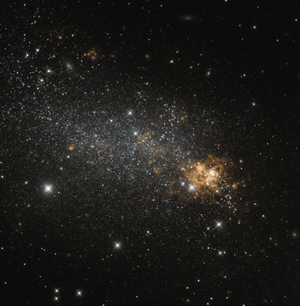NGC 5408
| Galaxie NGC 5408 | |
|---|---|
 | |
| Die Galaxie NGC 5408 aufgenommen vom Hubble-Weltraumteleskop. | |
| AladinLite | |
| Sternbild | Zentaur |
| Position Äquinoktium: J2000.0, Epoche: J2000.0 | |
| Rektaszension | 14h 03m 20,9s[1] |
| Deklination | −41° 22′ 40″[1] |
| Erscheinungsbild | |
| Morphologischer Typ | IB(s)m / HII[1] |
| Helligkeit (visuell) | 11,6 mag[2] |
| Helligkeit (B-Band) | 12,2 mag[2] |
| Winkelausdehnung | 1,9′ × 1′[2] |
| Positionswinkel | 62°[2] |
| Flächenhelligkeit | 12,1 mag/arcmin²[2] |
| Physikalische Daten | |
| Zugehörigkeit | LGG 344[1][3] |
| Rotverschiebung | 0,001688 ± 0,000010[1] |
| Radialgeschwindigkeit | (506 ± 3) km/s[1] |
| Hubbledistanz H0 = 73 km/(s • Mpc) | (16 ± 1) · 106 Lj (5,01 ± 0,36) Mpc [1] |
| Durchmesser | 10.000 Lj[4] |
| Geschichte | |
| Entdeckung | John Herschel |
| Entdeckungsdatum | 5. Juni 1834 |
| Katalogbezeichnungen | |
| NGC 5408 • PGC 50073 • ESO 325-047 • MCG -07-29-006 • IRAS 14002-4108 • 2MASX 14032090-4122397 • GC 3742 • h 3553 • | |
NGC 5408 ist eine irreguläre Zwerggalaxie vom Hubble-Typ IBm im Sternbild Zentaur am Südsternhimmel, die etwa 16 Millionen Lichtjahre von der Milchstraße entfernt ist. Innerhalb des Objekts befindet sich die sehr leuchtkräftige Röntgenquelle NGC 5408 X-1, ein Schwarzes Loch mit der 2.000-fachen Masse unserer Sonne.[5]
Gemeinsam mit sieben weiteren Galaxien bildet sie die NGC-5128-Gruppe (LGG 344).
Das Objekt wurde am 5. Juni 1834 von dem britischen Astronomen John Herschel entdeckt.[6]
Weblinks
- NGC 5408. SIMBAD, abgerufen am 27. Februar 2016 (englisch).
- astronews.com: Bild des Tages 19. Januar 2016
- Rebel rebel (engl.)
- NGC 5408. DSO Browser, abgerufen am 27. Februar 2016 (englisch).
- CDS Portal
Einzelnachweise
Auf dieser Seite verwendete Medien
Autor/Urheber: Judy Schmidt from Fresh Meadows, NY, USA, Lizenz: CC BY 2.0
This is an irregular galaxy once mistaken for a planetary nebula. I managed to combine a couple of infrared filters (more or less grey) from the WFC3 with some H-alpha (orange) data from the WFPC2 for an interesting result. What bothers me here is that I have no idea how to obtain some x-ray data because if I had that then I could point to it and say there's some kind of black hole accretion disk of some sort going on there, which is creating an ultra-luminous x-ray source (astronomers get to use all the cool words). Looking at the citations for NGC 5408 X-1, it must be a pretty neat thing because it gets cited over and over again.
Conclusion: Astrophysicists love black holes. Who doesn't, though?
Data from these two proposals were used: An Irradiated Disk in an Ultraluminous X-Ray Source The Recent Star Formation History of SINGS Galaxies
Red: WFC3/IR F160W + hst_11987_29_wfpc2_f656n_wf_sci Green: Pseudo Blue: WFC3/IR F105W
North is up.